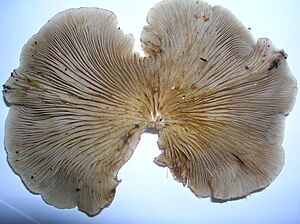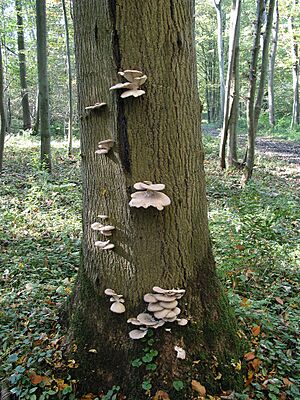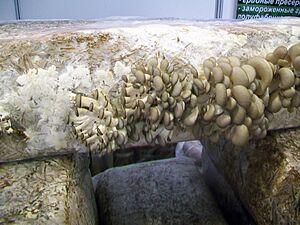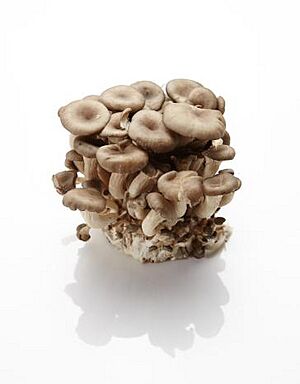Oyster mushroom facts for kids
Quick facts for kids Oyster mushroom |
|
|---|---|
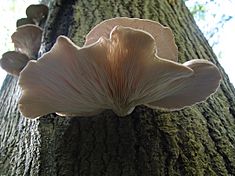 |
|
| Oyster mushroom | |
| Scientific classification | |
| Kingdom: | |
| Division: | |
| Class: | |
| Order: |
Agaricales
|
| Family: |
Pleurotaceae
|
| Genus: |
Pleurotus
|
| Species: |
P. ostreatus
|
| Binomial name | |
| Pleurotus ostreatus |
|
| Pleurotus ostreatus | |
|---|---|
| Mycological characteristics | |
| gills on hymenium | |
| cap is offset | |
| hymenium is decurrent | |
| stipe is bare | |
| spore print is white | |
| ecology is saprotrophic | |
| edibility: choice | |
The oyster mushroom (scientific name: Pleurotus ostreatus) is a very common and tasty mushroom. It is also known as the oyster fungus or hiratake in Japanese. People first started growing it in Germany during World War I. Today, it is grown all over the world for food.
This mushroom is related to the king oyster mushroom, which is also grown for food. Oyster mushrooms can also be used in a special process called mycoremediation. This means they can help clean up polluted areas.
The oyster mushroom is one of the most popular wild mushrooms to find. You can also grow it easily on straw or other materials. It has a slightly sweet smell, a bit like bitter almonds.
Contents
What's in a Name?
Both the Latin and common names for this mushroom describe its shape. The Latin word pleurotus means "sideways." This refers to how the stem often grows sideways from the cap.
The Latin word ostreatus and the English name "oyster" refer to the cap's shape. It looks a lot like an oyster shell! Some people also think it tastes a bit like oysters, which makes the name even more fitting.
The name "oyster mushroom" is also used for other types of Pleurotus mushrooms. Sometimes, people call Pleurotus ostreatus the "grey oyster mushroom." This helps tell it apart from other similar species.
Mushroom Features
The oyster mushroom has a wide cap that looks like a fan or an oyster shell. It can be anywhere from 2 to 30 centimeters (about 1 to 12 inches) across. Wild mushrooms can be white, gray, tan, or dark brown. The edges of the cap are often wavy or slightly curled when the mushroom is young.
The inside of the mushroom is white and firm. The gills, which are the thin plates under the cap, are white or cream-colored. They run down the stem if there is one.
The stem of the oyster mushroom is often missing. If it is there, it is usually short and thick. It is also often attached to the side of the cap, not in the middle. The mushroom's spore print is white to lilac-gray. A spore print is like a fingerprint for mushrooms, made by their tiny reproductive cells.
Dangerous Lookalikes
There are some mushrooms that look like the oyster mushroom but are not safe to eat. For example, Omphalotus nidiformis is a toxic mushroom found in Australia and Japan. In North America, Omphalotus olivascens (the western jack-o'-lantern mushroom) and Clitocybe dealbata (the ivory funnel mushroom) can also look similar. Both of these contain a harmful substance called muscarine and are poisonous. It is very important to only eat mushrooms that you are absolutely sure are safe!
How it Eats Meat
Did you know that P. ostreatus is a carnivorous fungus? This means it eats other living things! It preys on tiny worms called roundworms. The mushroom uses a special toxin that paralyzes the worms very quickly. After the worms are paralyzed, the mushroom breaks them down. This helps the mushroom get important nutrients, especially protein, from the worms.
Where it Lives
The oyster mushroom grows in many forests around the world, especially in places with mild or warm climates. However, it is not found in the Pacific Northwest of North America. Other similar species grow there instead.
This mushroom is a saprotroph. This means it gets its food by breaking down dead things. It is a main decomposer of wood, especially wood from deciduous trees (trees that lose their leaves). It is known as a "white-rot wood-decay" fungus because it causes the wood to rot and turn white.
As mentioned before, the oyster mushroom is one of the few mushrooms that eats meat. Its mycelia (the root-like parts of the fungus) can kill and digest nematodes. This helps the mushroom get nitrogen, which is a very important nutrient.
You can find standard oyster mushrooms growing in many places. Some other related species, like the branched oyster mushroom, only grow on trees. In the UK, you can find oyster mushrooms all year round.
Even though this mushroom often grows on dying hardwood trees, it is not actually harming the tree. It is helping the forest by breaking down the dead wood. This process returns important nutrients and minerals to the soil. These nutrients can then be used by other plants and organisms, which helps the whole forest ecosystem.
How We Use It
Cooking with Oyster Mushrooms
The oyster mushroom is a popular and delicious edible mushroom. It is considered a special food in Japanese, Korean, and Chinese cuisine. People often serve it by itself, in soups, or in stir-fry dishes with soy sauce. You can also use oyster mushrooms to make sauces, like a vegetarian oyster sauce.
The mushroom has a mild taste and a slight smell similar to anise. In Czech and Slovak cooking, oyster mushrooms are used in soups and stews, often as a substitute for meat. It is best to pick oyster mushrooms when they are young. As they get older, they can become tough and have an unpleasant taste.
Other Cool Uses
Beyond food, the pearl oyster mushroom has some amazing other uses! People are using its mycelium (the network of fungal threads) to create new materials. These include "mycelium bricks" for building, "mycelium furniture," and even leather-like products.
Oyster mushrooms have also been used to clean up soil polluted with diesel oil. The mushroom was able to change 95% of the oil into compounds that were not harmful. This shows how useful fungi can be for our environment!
Similar Species
Some mushrooms that look similar to the oyster mushroom include Pleurocybella porrigens, Hohenbuehelia petaloides, and the hairy-capped Phyllotopsis nidulans.
See also
 In Spanish: Pleurotus ostreatus para niños
In Spanish: Pleurotus ostreatus para niños


